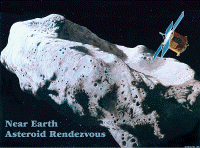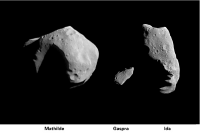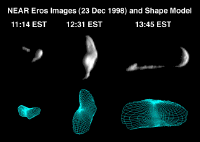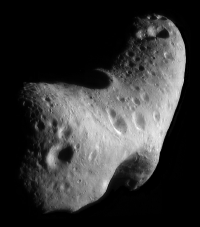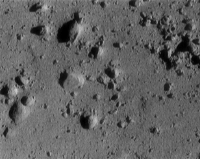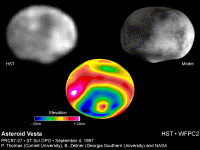Asteroids
Discoveries
For a long time, the only information obtained on asteroids was through Earth-based observations and photographs. In recent years, radar observations have been made of several asteroids as they pass close to the Earth.
A major breakthrough came in 1983 with the UK - Netherlands - USA Infrared Astronomy Satellite (IRAS), which observed more than 1800 asteroids. Among its discoveries was an unusual asteroid, 3200 Phaethon, which seems to be an extinct comet.
However, most of our knowledge about asteroids comes from close-up observations by spacecraft.
- Galileo: On its way to Jupiter, Galileo flew past main-belt asteroid 951 Gaspra on 29 October 1991 and obtained the first high resolution images of an asteroid. On 28 August 1993, the spacecraft had a close encounter with main-belt asteroid 243 Ida. (NASA).
- NEAR Shoemaker (Near Earth Asteroid Rendezvous): A NASA Discovery mission. NEAR made a fast flyby of main-belt asteroid 253 Mathilde on 27 June 1997. It then became the first spacecraft to visit a near-Earth asteroid, 433 Eros on 23 December 1998. Orbital insertion failed, but NEAR was able to obtain over 1000 distant images of Eros. During a second attempt, NEAR successfully entered orbit around Eros on 14 February 2000 and began to map its surface at high resolution. On 12 February 2001 it became the first spacecraft to land on an asteroid (NASA).
- Deep Space 1: A NASA New Millennium mission to try out innovative technology, particularly an ion drive and an autonomous navigation system. Completed a flyby of asteroid 9969 Braille, on 28 July 1999, but images were limited to a few distant views when the spacecraft cameras failed to point towards the dark target (NASA).
- Cassini: On its way to Saturn, Cassini crossed the Asteroid Belt and took pictures of asteroid 2685 Masursky on 23 January 2000. The images revealed that the side of Masursky imaged by Cassini is roughly 15 - 20 km across. (ESA/NASA).
- Muses-C: Japanese mission scheduled for launch in late 2002. The first Asteroid Sample Return mission. The spacecraft will make a landing on near-Earth asteroid 1998 SF36 in 2005 and return a soil sample to Earth in June 2007. (ISAS/NASA).
- Rosetta: Scheduled for launch in 2004, Rosetta will encounter at least one asteroid on its journey to Comet 67P/Churyumov-Gerasimenko. (ESA).
- Dawn: A NASA mission to rendezvous and orbit the asteroids 4 Vesta and 1 Ceres. Scheduled for launch in mid-2006, Dawn will reach Vesta in July 2010. After about one year orbiting the asteroid it will depart for Ceres, arriving in August 2014.
Four spacecraft have examined
asteroids at close quarters. Three
of these obtained snapshots of their
rocky targets as they zipped past
at high speed. Only the NEAR
spacecraft has so far entered orbit
around an asteroid (Eros), made
long term observations and finally,
landed on the asteroid.
Asteroids visited
This image shows three main-belt
asteroids that have been visited by
spacecraft. Gaspra and Ida were
imaged by the Galileo spacecraft
while Mathilde was imaged by the
NEAR spacecraft. The asteroids are
shown to scale.
951 Gaspra
The first asteroid visited by a spacecraft. On 29 October 1991, NASA's Galileo spacecraft encountered it near the inner edge of the main asteroid belt between Mars and Jupiter. The spacecraft passed about 1600 km from Gaspra at a relative speed of 8 km per second. The pictures revealed a cratered, very irregularly shaped body, which measures about 19 x 12 x 11 km. Over 600 craters have been identified on Gaspra, the largest of which is about 1.5 km across. It is also covered by numerous small fractures. Gaspra is a member of the Flora family of main-belt asteroids.
243 Ida and Dactyl
Ida was the first asteroid proved to have a tiny moon, Dactyl. It was visited on 28 August 1993 by the Galileo spacecraft, which flew within 2400 km of the asteroid. Ida is about 58 x 23 x 21 km in size, twice as large as Gaspra, while Dactyl is a mere 1.5 km across. Ida's average distance from the Sun is 428 million kilometre (nearly three times the Earth's distance). Like Gaspra, it is heavily cratered and probably composed of silicates, but it also has a scattering of large boulders and is probably covered with a deep layer of fine material. Both Ida and Gaspra are considered to be common S-type main-belt asteroids. Surprisingly, Dactyl, which orbits only 100 km from Ida, appears to be made of different materials than its large neighbour.
253 Mathilde
The largest asteroid so far visited by a spacecraft, Mathilde is 52 km in diameter, four times the size of Gaspra. On 27 June 1997, NASA's NEAR satellite made a 25 minute flyby of Mathilde and took more than 500 images of this very unusual little world. Until then, little was known about Mathilde. Discovered in 1885, it is one of the blackest objects in the Solar System, reflecting only 3% of the light that strikes it. Its rotation period of 417 hours is one of the longest known so far. Mathilde is a C-type asteroid. It has a very low density, only 30% greater than water, which suggests that it is extremely porous. Some scientists believe it is little more than a giant rubble pile. Its shape is dominated by huge craters - at least four exceed Mathilde's average radius!
9969 Braille (1992 KD)
Named Braille shortly before the arrival of NASA's Deep Space 1 spacecraft in December 1998. Distant images show that it is very black and possibly similar in composition to the large asteroid Vesta. It may be a piece which broke away from Vesta during a past collision.
Most asteroids have very irregular
shapes, mainly because they have
suffered many impacts over billions
of years. These impacts have left
large craters, as seen in this
computer model which shows the
shape of Eros.
433 Eros
Close-up images from the NEAR spacecraft show a peanut-shaped object with a maximum diameter of 33 km, making it much larger and more massive than the object which struck the Earth 65 million years ago and wiped out the dinosaurs. The asteroid's density is 2.4 times greater than water.
While NEAR Shoemaker orbits Eros,
the asteroid appears too large for
the camera's field of view. In order
to get a complete view of the
surface from a particular vantage
point, several images are
mosaicked. To do this, the digital
images returned by the spacecraft
are draped over a computer model
of the asteroid's shape (NASA/
NEAR/The Johns Hopkins University).
NEAR has also revealed numerous craters and a large depression known as 'the saddle'. The density of giant craters on Eros is not as high as on Mathilde, but there are noticeably more than were seen on Gaspra. The NEAR data show that Eros has an older surface than Gaspra - Eros has been exposed to bombardment by other asteroids for a longer period of time.
Numerous boulders litter the pockmarked surface.
NEAR Shoemaker's image of
asteroid 433 Eros taken from a
range of 250 metres. The image is
12 metres across. The cluster of
rocks at the upper right measures
1.4 metres across. Different amounts
of burial of the rocks and boulders
are evident. Image courtesy of the
NEAR Project (JHU/APL).
NEAR's cameras have also revealed nearly parallel markings, chains of small craters or pits, and grooves. One interpretation is that Eros has a layered internal structure which was produced while Eros was part of a much larger parent body that was broken up long ago by a gigantic collision.
2685 Masursky
On 23 January 2000, this main-belt asteroid was observed by the Cassini spacecraft from a distance of 1.6 million kilometres. Images indicated that the asteroid is roughly 15 - 20 km across. It is probably an S-type object. The asteroid is named after renowned planetary geologist Harold Masursky (1923-1990).
Asteroid vital statistics
|
Average distance from Sun (million km) |
428 |
396 |
218 |
330 |
350 |
|
Orbital period (yrs) |
4.84 |
4.31 |
1.76 |
3.29 |
3.58 |
|
Maximum length (km) |
58 |
66 |
33 |
19 |
2.2 |
|
Rotation period (hrs) |
4.63 |
417.7 |
5.27 |
7.04 |
- |
|
Orbital inclination (degrees) |
1.14 |
6.71 |
10.83 |
4.10 |
29.0 |
|
Orbital eccentricity |
0.045 |
0.266 |
0.223 |
0.174 |
0.434 |
|
Asteroid type |
S |
C |
S |
S |
- |
|
Year of discovery |
1884 |
1885 |
1898 |
1916 |
1992 |
Other famous asteroids
1 Ceres
The first asteroid ever discovered. It was found by Italian astronomer Giuseppi Piazzi in 1801. It is about 930 km across and accounts for more than a quarter of the mass of all the main-belt asteroids combined. It takes 4.6 years to go once around the Sun.
A Hubble Space Telescope image
of the asteroid Vesta, taken in May
1996 with the ESA Faint Object
Camera when the asteroid was
110 million miles from Earth. The
map shows that the southern pole
is dominated by a depression (blue)
which is a large impact feature.
4 Vesta
Discovered in 1807, Vesta is the fourth largest asteroid, after 2001 kx76, Ceres and Pallas, with a diameter of about 510 km. It is the brightest asteroid and visible to the naked eye. Observations by the Hubble Space Telescope show that Vesta has a large circular hollow, probably an impact crater, near its south pole. The 460 km wide basin is about 12 km deep and has a pronounced central peak. It is probably made of basaltic material, similar to the rock commonly found in lava flows on the Earth and Moon. This suggests that it was once molten.
2060 Chiron
Discovered in 1977 by Charles Kowal, Chiron spends its entire life in the outer Solar System, between the orbits of Jupiter and Neptune. Chiron was the first of a family of objects, known as Centaurs, that have been found there. Astronomers were surprised in 1989 when it was suddenly surrounded by a coma (cloud of gas and dust). This comet-like behaviour led to it also being designated Comet 95P/Chiron. It is grey in colour and has a diameter of about 200 km.
3200 Phaethon
Discovered in 1983 by the UK-Netherlands-USA Infrared Astronomical satellite (IRAS). Phaethon, which is about 6 km across, follows a highly elliptical, Earth-crossing orbit. It seems to be the source of the dust particles which produce the Geminid meteor shower each December. It may be the 'dead' nucleus of an old comet.
1862 Apollo
Discovered in 1932 by K. Reinmuth, this 1.4 km diameter object was the first asteroid found to follow a path which crossed the orbit of the Earth. Hundreds of Apollo-type asteroids have now been discovered.
Rosetta's asteroid flybys
| Asteroids | F (Km) |
(m/s) | Fly-by date | Vr (Km/s) | rE (AU) | rB (AU) |
a |
a |
a |
Comments |
| Asteroids in ARC E AR2-EAR3 | ||||||||||
| 1714 / Sy | 19.2 | 5 | 2009/03/06 | 8.21 | 2.98 | 2.22 | 126.6 | 139.0 | 14.3 | NAVCM |
| 2513 / B | 0 | 15 | 2008/10/04 | 8.58 | 2.68 | 2.21 | 34.6 | 14.5 | 21.0 | OK |
| 5538 / | 0 | 32 | 2009/04/03 | 5.50 | 2.61 | 2.14 | 105.6 | 125.8 | 21.6 | TBC |
| 3050 / Carrera | 0 | 67 | 2008/08/04 | 11.14 | 1.77 | 2.04 | 26.1 | 4.0 | 29.9 | OK |
| 2867 / Steins | 0 | 73 | 2008/09/06 | 8.57 | 2.42 | 2.13 | 38.5 | 15.9 | 24.6 | TBC |
| 437 / Rhodia | 14.3 | 75 | 2008/09/17 | 11.25 | 2.64 | 2.14 | 41.2 | 31.0 | 21.2 | Sun Depointing |
| 1393 / | 0 | 100 | 2008/09/22 | 6.58 | 2.52 | 2.18 | 60.7 | 37.8 | 23.2 | Sun Depointing |
| Asteroids in ARC EAR3-COMET | ||||||||||
| 3418 / | 21.1 | 11 | 2010/12/04 | 11.3 | 4.45 | 3.68 | 20.0 | 28.5 | 8.6 | TBC |
| 2181 / | 0 | 16 | 2010/05/25 | 13.56 | 2.00 | 2.37 | 21.5 | 17.1 | 25.3 | TBC |
| 21 / Lutetia | 99.5 | 130 | 2010/0710 | 15.0 | 3.04 | 2.72 | 11.1 | 8.5 | 19.3 | TBC |

